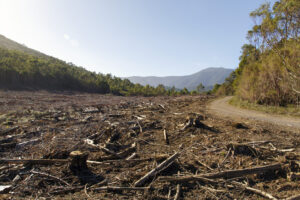Tasmania’s native forests are globally recognised for their unique species and conservation value, as well as being some of the most carbon dense forests on the planet.
As other states put an end to native forest logging, Tasmania continues to delay the inevitable end of an industry that is a relatively small employer, heavily subsidised by the taxpayer and causes climate change and habitat loss.
Now is the time to protect Tasmania’s irreplaceable native forests and support native forestry workers to move to sustainable industries. Add your name to our petition.
Why are Tasmania’s native forests important?
Tasmania’s native forests are globally recognised for their unique species and their conservation value. They are also some of the most carbon-dense forests on the planet. Emissions from native forest logging in Tasmania have been estimated at 4.65 million tonnes of CO2 equivalent per year, making it the highest emitting sector in the Tasmanian economy.
The reduction in native forest logging since 2011 has been a major factor in the state’s achievement of negative greenhouse emissions, along with hydroelectricity.

How many people work in native forest logging?
Census figures show that just 885 people worked in all forestry and logging in Tasmania in 2021. This includes both plantation and native forestry. There were a further 1,430 workers
across all wood product and paper manufacturing industries. In total, this represents just under 1% of all Tasmanian jobs—and only a fraction of these are actually dependent on native forestry and most could be transitioned to plantation log supply.
A 2018 report commissioned by a forestry industry body estimated that there were 1,112 jobs in native forestry activities, including growing, harvest, haulage and primary processing, down from 4,120 in 2006. It estimated total forest industry jobs in Tasmania at 3,076, 1.4% of the labour force.
Does Tasmania log more native forest than other states?
Yes. 25% of Tasmania’s wood product comes from native forest, compared to just 9% for the rest of Australia.
Tasmania accounts for 40% of all native forest log volume in Australia, more than WA, NSW and Queensland combined. Nationally, 88% of wood product comes
from plantations, with this number set to rise as Victoria and WA end native forest logging by 2024.
Does native forest logging make money for Tasmania?
No. Sustainable Timbers Tasmania (STT) — the government-owned business enterprise that manages logging in native forests — has been heavily subsidised by the Tasmanian Government. Over the period 1997-2017 STT suffered a cash loss of $454 million and wrote down the asset value of the forest estate by $751 million.
In its 2022 Annual Report, STT reported cash receipts from non-government customers of product of $102 million versus expenses of $112 million.
How much of the forest ends up as sawlog?
When a forest is logged, less than 1% of that forest’s biomass ends up as a sawn timber product.
Some 60% of the forest’s biomass is simply left on site, and either burned or left to rot. Of the 40% of biomass that is removed, only 10% (4% of the total biomass) becomes sawlog — and only 25% of those logs (1% of the total biomass) becomes sawn timber.
You can protect these national treasures, and help to end native forest logging by adding your name to our petition.
For references and sources see the downloadable factsheet below.
Related documents
Between the Lines Newsletter
The biggest stories and the best analysis from the team at the Australia Institute, delivered to your inbox every fortnight.
You might also like
The logging industry should be bound by Australia’s environment protection laws just like everyone else
This week, a private member’s bill to end native forest logging was up for debate. It sought to repeal legislation that exempts logging in much of Australia’s public forest estate from our national environment laws.
Five priorities for the next parliament if we want a liveable Australia
Climate and nature crises won’t pause while politics plays out.
Unfinished Business: Towards a settlement on Aboriginal land rights in the ACT
The Australia Institute has today published a discussion paper on the barriers to progress on Aboriginal land rights in the ACT. The paper explores the issues that need to be resolved before the ACT Government can make progress on treaty discussions. Key Findings: The transfer of the land of the ACT from NSW to the


